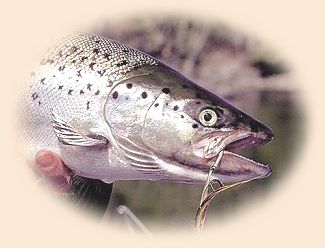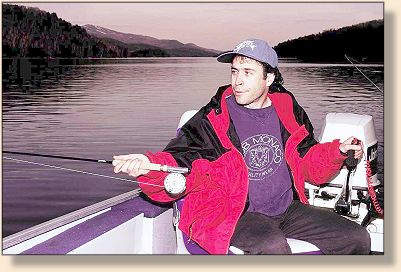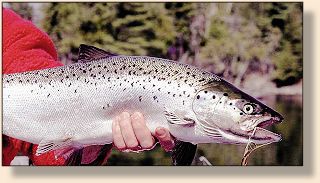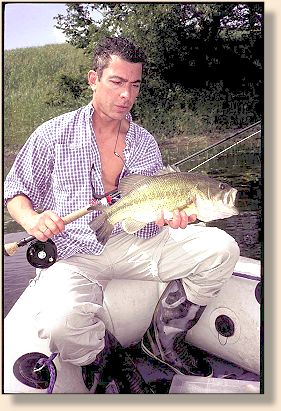Lac du Cerf

By Ari Vineberg, Photos by Mark Krupa
While most regions in the province of Quebec can boast their share of pristine
lakes with good populations of landlocked salmon (in Quebec, called "ounaniche"),
the good waters tend to be victims of their own notoriety and, consequently, have
become somewhat over-fished. In the southeastern part of the province, Lake
Memphremagog is a prime example, for while the fishing there is still quite good,
you have to have your boat in the line-up at the dock by 3 a.m. if you want to be
on water by sunrise. Further up north, Lac St-Jean receives the same pressure.
In the Laurentians, the exceptional lakes such as Tremblant or Ouimet are at the
opposite end of the spectrum: uncrowded, but hard to access as all land
surrounding them is private. It seems that there are few accessible ounaniche waters left.
One of the few is Lac du Cerf. Located in the Laurentian mountains about 150km
Northeast of Montreal, just south of Mont Laurier, Lac Du Cerf is a paradise for
those in search of silver dreams. Nestled between the mountain lowlands, it is a
slice of pure wilderness where the air is crisp and redolent with the smell of pine
and the water is cold, crystal clear, and full of fish.

The fishery is an important component of community life in the tiny municipality of
Lac Du Cerf, and everyone seems to have a vested interest in its continued success.
In spring, just after ice-out, the one thing on everybody's mind seems to be the
ounaniche. At night, fish stories are recounted in the barroom at the motel, every
day the registry at the garage is scrutinized for the latest catches, and people walk
down to the public dock in the evening after supper to watch anglers returning
with their catch.
Fishery Management
It should be no surprise that the community is deeply involved in the fishery. In fact,
since 1987 the local Fish & Game Association, taking over for the government, has
been responsible for all salmon stocking and management in the area lakes. Decisions
are made in the community by those most affected by their outcome, around kitchen
tables, in the church on Sundays, and in the aisles of the grocery store. These people
take their salmon seriously.
Visiting anglers are encouraged to become members of the local Fish & Game Association.
The membership is a paltry $10.00 and the revenue is used to fund fishery management
projects. Between 1990-1995 there have been over one hundred thousand eggs and
twenty thousand salmon, between 4 and 40 cm, planted in the two adjoining lakes,
Grand Lac et petit Lac du Cerf. These fish originated at the fish hatchery in St. Felician
in the Lac St. Jean area and were the first landlocked salmon introduced.
The return rates of these original fish has been excellent in the last few years, and just
recently, the association completed a $35,000 project to create more favorable spawning
beds on Flood Creek where the fish could reproduce naturally. So far, the scheme seems
to be working and spawning surveys in the fall conducted by the association indicate
that the fish are successfully using the creek to reproduce. Populations of ounaniche
remain abundant, and last year a specimen weighing slightly above 10 pounds was
taken - a lake record.
When, Where, and How
As a general rule with all landlocked salmon fishing, the best periods are immediately
after ice-out in the spring and, again, in late fall when the water temperature begins to
cool down. Depending on the weather conditions and the severity of the winter, the
time of ice-out varies, but it usually occurs in mid to late April, in time for the opening
of the season on April 27.
One of the first places to open up is Baie de l'Eglise, which is the northernmost bay and
therefore receives much of the warming rays of the spring sun. The best fishing at Baie
de l'Eglise is adjacent to the public boat launch, from the mouth of Baie de Bonnet up to
the straits that separate Petit and Grand Lac du Cerf. On the other side of Baie de l'Eglise
the sand bars are equally promising. Baie des Scouts and Baie Lefevbre are also good
choices early in the season.

As the water warms towards June, ounaniche will begin to move off to deeper water,
but while the window of opportunity is short, it offers lots of action and with plenty
of fish averaging 4-6 pounds the fishing can be excellent. The best periods to fish are
early in the morning between 5-7 a.m. and in the evening at dusk, although it is not
uncommon to pick fish up during the day.
Unlike most Laurentian shield lakes that harbour populations of salmon, there are no
smelt in either of the lakes that comprise Lac du Cerf. The predominant forage fish is
lake cisco, which is locally referred to as lake herring. There are tremendous schools
of them roaming this oligotropic lake, and the salmon relate to these in the spring rather
than to shoreline or underwater structure. Unlike smelt, which make spawning runs in
the creeks in the spring, cisco spawn in the lake in the fall, making salmon location
much more predictable, particularly in the spring.

Most fly fishers choose to troll tandem hook streamers slowly off sand bars and the points
of bays, where shoals of cisco tend to locate. While casting is certainly an option, it is
somewhat similar to trying to find a needle in a haystack, as there is so much water to
cover in the 9.9 km-long lake and the fish are constantly on the prowl. A depth finder
is a tremendous help in locating the shoals and, consequently, the ounanich, more
precisely.
A seven or eight weight rod with a full sinking or sink tip line is an ideal. The most
popular and productive flies include the Mickey Finn, Magog Smelt, Grey Ghost,
Electric Smelt, Brown-nosed Dace and other streamer patterns which approximate
cisco. Because of the excellent water clarity, somewhere between 40 and 50 feet,
the fish are easily spooked and finesse is required when selecting terminal tackle.
A long fluorocarbon leader, between 10 and 15 feet, tapering down to 5-6x is
recommended to optimize chances of success.
If fishing more than one rod, use both a short and long line presentations to increase
hook-ups. The short rod should be fished between 35-50 feet behind the boat (preferably
in the propwash); the long rod at twice that distance. A few, short, staccato movements
should be imparted to the fly every so often to increase its action. In order to accomplish
this, hold the rod with its length parallel to the boat and use your elbow to pump it back
and forth, as if you were sawing a two-by-four. Do not hold rod at right angles to the
side of the boat, as this creates too much slack in the line to set the hook properly when
a fish hits. When you do get a hit, expect the ounaniche to go airborne several times in
an effort to shake the hook and return to freedom.
Other Species

While the ounaniche are the real drawing card at Lac du Cerf, there are plenty of other
species available to provide action during the salmon's mid-day siesta. By mid-May, huge
pike spawn in the back bays, and it is not uncommon to see schools of them sunning in the
crystalline water over the sand shoals in Bay de L'Eglise at this time. At first glance, they
resemble sunken logs - until they begin to move. Because these fish feed mainly on ciscos,
which are extremely oily and high in protein content, they reach quite impressive sizes.
The lake record is over 40 pounds.
 There are also lake trout, muskie, and smallmouth bass in numbers and size ranges sufficient
to warrant some serious consideration. Once again, most of these fish relate to the cisco
rather than structure and tend to be deep-water oriented, often suspended in the water column.
There are also lake trout, muskie, and smallmouth bass in numbers and size ranges sufficient
to warrant some serious consideration. Once again, most of these fish relate to the cisco
rather than structure and tend to be deep-water oriented, often suspended in the water column.
As these are deep, oligotropic lakes, there is not a tremendous amount of aquatic
vegetation or weedlines against which to toss your flies - a traditional approach for
mean greenies such as pike, smallmouth, and muskies! However, in Petit Lac du Cerf
there are a few shallow back bays with deadfalls which are a good bet for either pike
or smallmouth. There is also a mid-lake weedbed on this lake that holds both pike and
muskie by early summer. At night, the fish tend to move into the shallows to feed on
other minnows, and the straits adjoining the two lakes can be productive for both
pike and muskie at this time. ~ Ari Vineberg
Concluded next time.
|






 There are also lake trout, muskie, and smallmouth bass in numbers and size ranges sufficient
to warrant some serious consideration. Once again, most of these fish relate to the cisco
rather than structure and tend to be deep-water oriented, often suspended in the water column.
There are also lake trout, muskie, and smallmouth bass in numbers and size ranges sufficient
to warrant some serious consideration. Once again, most of these fish relate to the cisco
rather than structure and tend to be deep-water oriented, often suspended in the water column.